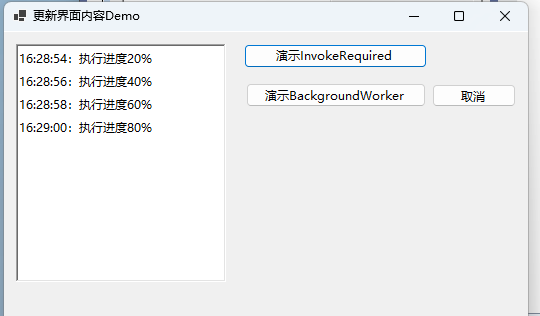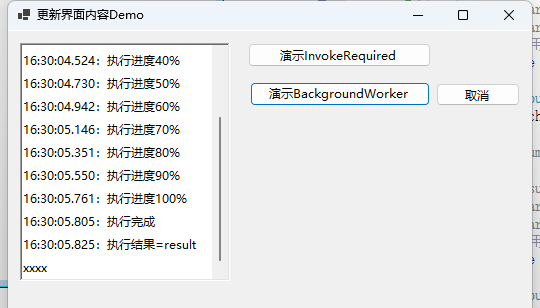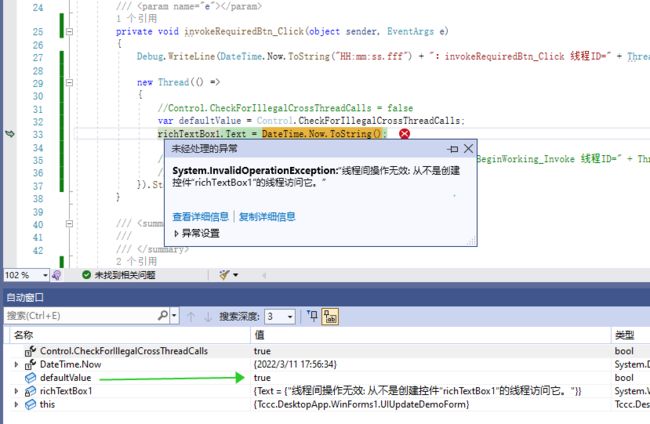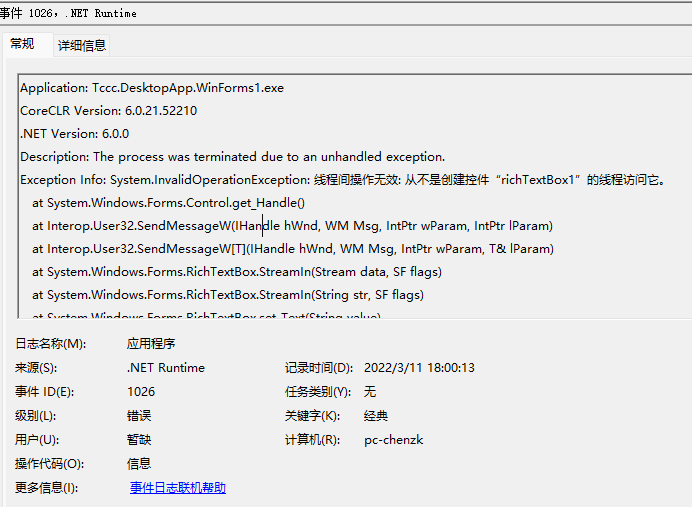这是一个古老的话题。。。直入主题吧!
对winfrom的控件来说,多线程操作非常容易导致复杂且严重的bug,比如不同线程可能会因场景需要强制设置控件为不同的状态,进而引起并发、加锁、死锁、阻塞等问题。为了避免和解决上述可能出现的问题,微软要求必须是控件的创建线程才能操作控件资源,其它线程不允许直接操作控件。但是现代应用又不是单线程应用,无论如何肯定会存在其它线程需要更新控件的需求,于是微软两种方案来解决相关问题:InvokeRequired方案和BackgroundWorker方案。
演示程序效果图和源码
using System.ComponentModel;
using System.Diagnostics;
using System.Timers;
using Tccc.DesktopApp.WinForms1.BLL;
namespace Tccc.DesktopApp.WinForms1
{
public partial class UIUpdateDemoForm : Form
{
///
///
///
public UIUpdateDemoForm()
{
InitializeComponent();
backgroundWorker1.WorkerReportsProgress = true;
backgroundWorker1.WorkerSupportsCancellation = true;
}
#region 演示InvokeRequired
///
///
///
///
///
private void invokeRequiredBtn_Click(object sender, EventArgs e)
{
Debug.WriteLine(DateTime.Now.ToString("HH:mm:ss.fff") + "invokeRequiredBtn_Click 线程ID=" + Thread.CurrentThread.ManagedThreadId);
new Thread(() =>
{
Debug.WriteLine(DateTime.Now.ToString("HH:mm:ss.fff") + "BeginWorking_Invoke 线程ID=" + Thread.CurrentThread.ManagedThreadId);
BLLWorker.BeginWorking_Invoke(this, "some input param");
}).Start();
}
///
///
///
public void UpdatingProgress(int progress)
{
if (this.InvokeRequired)
{
Debug.WriteLine(DateTime.Now.ToString("HH:mm:ss.fff") + "InvokeRequired=true 线程ID=" + Thread.CurrentThread.ManagedThreadId);
this.Invoke(new Action(() =>
{
Debug.WriteLine(DateTime.Now.ToString("HH:mm:ss.fff") + "Sleep2秒 线程ID=" + Thread.CurrentThread.ManagedThreadId);
Thread.Sleep(2000);//模拟UI操作慢
UpdatingProgress(progress);
}));
Debug.WriteLine(DateTime.Now.ToString("HH:mm:ss.fff") + "after Invoke 线程ID=" + Thread.CurrentThread.ManagedThreadId);
}
else
{
Debug.WriteLine(DateTime.Now.ToString("HH:mm:ss.fff") + "InvokeRequired=false 线程ID=" + Thread.CurrentThread.ManagedThreadId);
richTextBox1.Text += DateTime.Now.ToString("HH:mm:ss") + ":执行进度" + progress + "%" + Environment.NewLine;
}
}
#endregion
#region 演示BackgroundWorker
///
///
///
///
///
private void bgWorkerBtn_Click(object sender, EventArgs e)
{
new Thread(() =>
{
//Control.CheckForIllegalCrossThreadCalls = true;
//richTextBox1.Text = "可以了?";
}).Start();
Debug.WriteLine("bgWorkerBtn_Click 线程ID=" + Thread.CurrentThread.ManagedThreadId);
if (!backgroundWorker1.IsBusy)
{
richTextBox1.Text = String.Empty;
backgroundWorker1.RunWorkerAsync("hello world");//
}
}
private void bgWorkerCancelBtn_Click(object sender, EventArgs e)
{
Debug.WriteLine("bgWorkerCancelBtn_Click 线程ID=" + Thread.CurrentThread.ManagedThreadId);
if (backgroundWorker1.IsBusy)
{
backgroundWorker1.CancelAsync();//
}
}
///
///
///
///
///
private void backgroundWorker1_DoWork(object sender, DoWorkEventArgs e)
{
Debug.WriteLine("backgroundWorker1_DoWork 线程ID=" + Thread.CurrentThread.ManagedThreadId);
BLLWorker.BeginWorking(sender, e);//控件遍历传递到业务处理程序中
}
///
///
///
///
///
private void backgroundWorker1_ProgressChanged(object sender, ProgressChangedEventArgs e)
{
Debug.WriteLine("backgroundWorker1_ProgressChanged 线程ID=" + Thread.CurrentThread.ManagedThreadId);
richTextBox1.Text += Environment.NewLine + DateTime.Now.ToString("HH:mm:ss.fff") + ":执行进度" + e.ProgressPercentage + "%";
}
///
///
///
///
///
private void backgroundWorker1_RunWorkerCompleted(object sender, RunWorkerCompletedEventArgs e)
{
Debug.WriteLine("backgroundWorker1_RunWorkerCompleted 线程ID=" + Thread.CurrentThread.ManagedThreadId);
if (e.Cancelled)
{
richTextBox1.Text += Environment.NewLine + DateTime.Now.ToString("HH:mm:ss.fff") + ":已取消";
}
else if (e.Error != null)
{
richTextBox1.Text += Environment.NewLine + DateTime.Now.ToString("HH:mm:ss.fff") + ":发生错误:" + e.Error.Message;
}
else
{
richTextBox1.Text += Environment.NewLine + DateTime.Now.ToString("HH:mm:ss.fff") + ":执行完成";
richTextBox1.Text += Environment.NewLine + DateTime.Now.ToString("HH:mm:ss.fff") + ":执行结果=" + e.Result;
}
}
#endregion
}
public class BLLWorker
{
///
///
///
///
///
public static void BeginWorking_Invoke(UIUpdateDemoForm form, string inputData)
{
int counter = 0;
int max = 5;
while (counter < max)
{
System.Threading.Thread.Sleep(200);
counter++;
form.UpdatingProgress(counter * 20);
}
}
///
/// 模拟耗时操作(下载、批量操作等)
///
///
///
public static void BeginWorking(object sender, DoWorkEventArgs e)
{
BackgroundWorker worker = sender as BackgroundWorker;
Debug.WriteLine("inputArgument=" + e.Argument as string);
for (int i = 1; i <= 10; i++)
{
if (worker.CancellationPending == true)//检测是否被取消
{
e.Cancel = true;
break;
}
else
{
// Perform a time consuming operation and report progress.
System.Threading.Thread.Sleep(200);
worker.ReportProgress(i * 10);
}
}
e.Result = "result xxxx";
}
}
}
InvokeRequired方案
上述代码中,this.InvokeRequired属性就是用来判断当前线程和this控件的创建线程是否一致。
- 当其值=false时,代表当前执行线程就是控件的创建线程,可以直接操作控件。
- 当其值=true时,代表当前线程不是控件的创建线程,需要调用Invoke方法来实现操作控件。
问题来了,调用Invoke()怎么就能实现操作控件了呢?我们在演示程序中的UpdatingProgress()增加了详细的记录,调试输出如下:
16:47:44.907:invokeRequiredBtn_Click 线程ID=1
16:47:44.924:BeginWorking_Invoke 线程ID=11
16:47:45.133:InvokeRequired=true 线程ID=11
16:47:45.139:Sleep2秒 线程ID=1
16:47:47.144:InvokeRequired=false 线程ID=1
16:47:47.159:after Invoke 线程ID=11
16:47:47.363:InvokeRequired=true 线程ID=11
16:47:47.371:Sleep2秒 线程ID=1
16:47:49.392:InvokeRequired=false 线程ID=1
16:47:49.407:after Invoke 线程ID=11
16:47:49.622:InvokeRequired=true 线程ID=11
16:47:49.628:Sleep2秒 线程ID=1
16:47:51.638:InvokeRequired=false 线程ID=1
16:47:51.642:after Invoke 线程ID=11
16:47:51.857:InvokeRequired=true 线程ID=11
16:47:51.863:Sleep2秒 线程ID=1
16:47:53.880:InvokeRequired=false 线程ID=1
16:47:53.888:after Invoke 线程ID=11
16:47:54.099:InvokeRequired=true 线程ID=11
16:47:54.104:Sleep2秒 线程ID=1
16:47:56.118:InvokeRequired=false 线程ID=1
16:47:56.126:after Invoke 线程ID=11结合程序与执行日志,可以得到以下结论:
- 首先,在Invoke()方法前是线程11在执行,Invoke()内的代码就变成线程1在执行了,说明此处发生了线程切换。这也是Invoke()的核心作用:切换到UI线程(1号)来执行Invoke()内部代码。
- after Invoke日志的线程ID=11,说明Invoke()执行结束后,还是由之前的线程继续执行后续代码。
- after Invoke操作的日志时间显示是1号线程睡眠2秒后执行的,说明Invoke()执行期间,其后的代码是被阻塞的。
- 最后,通过程序总耗时来看,由于操作控件都需要切换为UI线程来执行,因此UI线程执行的代码中一旦有耗时的操作(比如本例的Sleep),将直接阻塞后续其它的操作,同时伴随着客户端程序界面的响应卡顿现象。
BackgroundWorker方案
BackgroundWorker是一个隐形的控件,这是微软封装程度较高的方案,它使用事件驱动模型。
演示程序的日志输出为:
bgWorkerBtn_Click 线程ID=1
backgroundWorker1_DoWork 线程ID=4
inputArgument=hello world
backgroundWorker1_ProgressChanged 线程ID=1
backgroundWorker1_ProgressChanged 线程ID=1
backgroundWorker1_ProgressChanged 线程ID=1
backgroundWorker1_ProgressChanged 线程ID=1
backgroundWorker1_ProgressChanged 线程ID=1
backgroundWorker1_ProgressChanged 线程ID=1
backgroundWorker1_ProgressChanged 线程ID=1
backgroundWorker1_ProgressChanged 线程ID=1
backgroundWorker1_ProgressChanged 线程ID=1
backgroundWorker1_ProgressChanged 线程ID=1
backgroundWorker1_RunWorkerCompleted 线程ID=1通过日志同样可以看出:
- 其中DoWork事件的处理程序(本例的backgroundWorker1_DoWork)用来执行耗时的业务操作,该部分代码由后台线程执行,而非UI线程,也正因此,backgroundWorker1_DoWork代码中就无法操作控件资源。
- BackgroundWorker的其它几个事件处理程序,如backgroundWorker1_ProgressChanged、backgroundWorker1_RunWorkerCompleted,就都由UI线程来执行,因此也就可以直接操作控件资源。
Control.CheckForIllegalCrossThreadCalls是咋回事?
官方注释:
Gets or sets a value indicating whether to catch calls on the wrong thread
that access a control's System.Windows.Forms.Control.Handle property
when an application is being debugged.When a thread other than the creating thread of a control tries to access one of that control's methods or properties, it often leads to unpredictable results. A common invalid thread activity is a call on the wrong thread that accesses the control's Handle property. Set CheckForIllegalCrossThreadCalls to true to find and diagnose this thread activity more easily while debugging.
通俗理解:
虽然微软不建议其它线程操作控件,但是如果就这么写了,程序也能执行,比如下面的情况:
private void invokeRequiredBtn_Click(object sender, EventArgs e)
{
Debug.WriteLine(DateTime.Now.ToString("HH:mm:ss.fff") + ":invokeRequiredBtn_Click 线程ID=" + Thread.CurrentThread.ManagedThreadId);
new Thread(() =>
{
richTextBox1.Text = DateTime.Now.ToString();
}).Start();
}而Control.CheckForIllegalCrossThreadCalls这个属性就是用来设置,是否完全禁止跨线程的操作控件。当设置true,上述操作就完全不能执行了。
注意:在VS中F5调试时,此值默认=true。报错效果:
双击生成的exe执行时,此值默认=false,程序还可以执行。当Control.CheckForIllegalCrossThreadCalls设置为true时,双击exe执行程序会异常退出:
建议:如果是新开发的程序,建议设置为true,可以及早的发现隐患问题,避免程序复杂后需要付出高昂的分析成本。
总结
以上是winform开发的基础中的基础,本文在系统的查阅微软文档的基础上,通过演示程序推测和验证相关的逻辑关系。
同时联想到:由于控件的更新都需要UI线程来执行,因此当遇到程序客户端程序响应卡顿/卡死的情况,通过dump分析UI线程的堆栈,应该可以有所发现。



